Structure and axon outgrowth inhibitor binding of the Nogo-66 receptor and related proteins
- PMID: 12839991
- PMCID: PMC165649
- DOI: 10.1093/emboj/cdg325
Structure and axon outgrowth inhibitor binding of the Nogo-66 receptor and related proteins
Abstract
The myelin-derived proteins Nogo, MAG and OMgp limit axonal regeneration after injury of the spinal cord and brain. These cell-surface proteins signal through multi-subunit neuronal receptors that contain a common ligand-binding glycosylphosphatidylinositol-anchored subunit termed the Nogo-66 receptor (NgR). By deletion analysis, we show that the binding of soluble fragments of Nogo, MAG and NgR to cell-surface NgR requires the entire leucine-rich repeat (LRR) region of NgR, but not other portions of the protein. Despite sharing extensive sequence similarity with NgR, two related proteins, NgR2 and NgR3, which we have identified, do not bind Nogo, MAG, OMgp or NgR. To investigate NgR specificity and multi-ligand binding, we determined the crystal structure of the biologically active ligand-binding soluble ectodomain of NgR. The molecule is banana shaped with elongation and curvature arising from eight LRRs flanked by an N-terminal cap and a small C-terminal subdomain. The NgR structure analysis, as well as a comparison of NgR surface residues not conserved in NgR2 and NgR3, identifies potential protein interaction sites important in the assembly of a functional signaling complex.
Figures
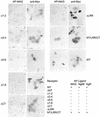
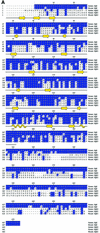

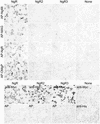
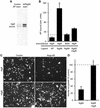

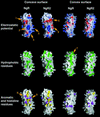

Similar articles
-
Molecular basis of the interactions of the Nogo-66 receptor and its homolog NgR2 with myelin-associated glycoprotein: development of NgROMNI-Fc, a novel antagonist of CNS myelin inhibition.J Neurosci. 2009 May 6;29(18):5768-83. doi: 10.1523/JNEUROSCI.4935-08.2009. J Neurosci. 2009. PMID: 19420245 Free PMC article.
-
Identification of a functional epitope of the Nogo receptor by a combinatorial approach using ribosome display.J Mol Biol. 2005 Sep 9;352(1):229-41. doi: 10.1016/j.jmb.2005.06.073. J Mol Biol. 2005. PMID: 16061255
-
Truncated soluble Nogo receptor binds Nogo-66 and blocks inhibition of axon growth by myelin.J Neurosci. 2002 Oct 15;22(20):8876-83. doi: 10.1523/JNEUROSCI.22-20-08876.2002. J Neurosci. 2002. PMID: 12388594 Free PMC article.
-
The Nogo receptor, its ligands and axonal regeneration in the spinal cord; a review.J Neurocytol. 2002 Feb;31(2):93-120. doi: 10.1023/a:1023941421781. J Neurocytol. 2002. PMID: 12815233 Review.
-
NgR acts as an inhibitor to axonal regeneration in adults.Front Biosci. 2008 Jan 1;13:2030-40. doi: 10.2741/2821. Front Biosci. 2008. PMID: 17981689 Review.
Cited by
-
Small-molecule-induced Rho-inhibition: NSAIDs after spinal cord injury.Cell Tissue Res. 2012 Jul;349(1):119-32. doi: 10.1007/s00441-012-1334-7. Epub 2012 Feb 21. Cell Tissue Res. 2012. PMID: 22350947 Free PMC article. Review.
-
No Nogo66- and NgR-mediated inhibition of regenerating axons in the zebrafish optic nerve.J Neurosci. 2009 Dec 9;29(49):15489-98. doi: 10.1523/JNEUROSCI.3561-09.2009. J Neurosci. 2009. PMID: 20007473 Free PMC article.
-
Myelin-associated glycoprotein-mediated signaling in central nervous system pathophysiology.Mol Neurobiol. 2006 Oct;34(2):81-91. doi: 10.1385/MN:34:2:81. Mol Neurobiol. 2006. PMID: 17220531 Review.
-
In a Class of Their Own - RXFP1 and RXFP2 are Unique Members of the LGR Family.Front Endocrinol (Lausanne). 2015 Sep 7;6:137. doi: 10.3389/fendo.2015.00137. eCollection 2015. Front Endocrinol (Lausanne). 2015. PMID: 26441827 Free PMC article. Review.
-
Characterization of myelin ligand complexes with neuronal Nogo-66 receptor family members.J Biol Chem. 2007 Feb 23;282(8):5715-25. doi: 10.1074/jbc.M609797200. Epub 2006 Dec 21. J Biol Chem. 2007. PMID: 17189258 Free PMC article.
References
-
- Bartsch U. et al. (1995) Lack of evidence that myelin-associated glycoprotein is a major inhibitor of axonal regeneration in the CNS. Neuron, 15, 1375–1381. - PubMed
-
- Brunger A.T. et al. (1998) Crystallography & NMR system: a new software suite for macromolecular structure determination. Acta Crystallogr. D, 54, 905–921. - PubMed
-
- CCP4 (1994) The CCP4 suite: programs for X-ray crystallography. Acta Crystallogr. D, 50, 760–763. - PubMed
-
- David S. and Aguayo,A.J. (1981) Axonal elongation into peripheral nervous system ‘bridges’ after central nervous system injury in adult rats. Science, 214, 931–933. - PubMed
Publication types
MeSH terms
Substances
Associated data
- Actions
- Actions
- Actions
LinkOut - more resources
Full Text Sources
Other Literature Sources
Molecular Biology Databases
Research Materials
Miscellaneous

